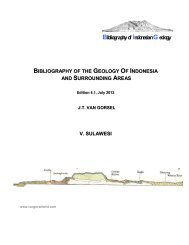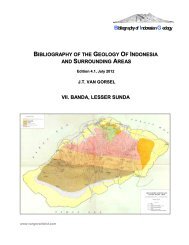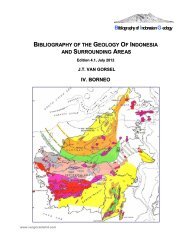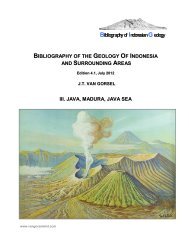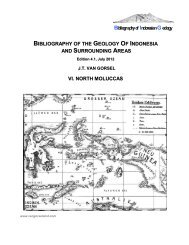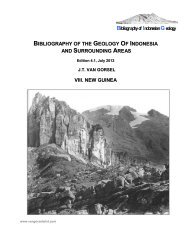Sumatra, Sunda Shelf, Natuna - Bibliography of Indonesia Geology
Sumatra, Sunda Shelf, Natuna - Bibliography of Indonesia Geology
Sumatra, Sunda Shelf, Natuna - Bibliography of Indonesia Geology
Create successful ePaper yourself
Turn your PDF publications into a flip-book with our unique Google optimized e-Paper software.
(M Miocene (N13-N14) sandstone in middle part <strong>of</strong> Baong Fm oil-bearing at Tabuhan Barat, Telaga Said,<br />
Darat oil Fields, and also at new Besitang discovery)<br />
Mulhadiono, R.P. Koesoemadinata & Rusnandar (1982)- Besitang River sand as the first turbidite reservoir in<br />
<strong>Indonesia</strong>. Proc. 11th Ann. Conv. Indon. Petrol. Assoc., 1, p. 265-298.<br />
(Productive M Miocene (zone N14) Besitang River sands in M Baong Fm, Aru area, N <strong>Sumatra</strong>, are turbidites<br />
within marine shale sequence. Fluid properties and production performance encourage further potential in<br />
structural and stratigraphic traps)<br />
Mulhadiono & Marinoadi (1977)- Notes on hydrocarbon trapping mechanism in the Aru area, North <strong>Sumatra</strong>.<br />
Proc. 6th Ann. Conv. Indon. Petrol. Assoc., p. 95-115.<br />
(N <strong>Sumatra</strong> Lower Baong and Pre-Baong are best source rocks. Vertical migration important in trapping <strong>of</strong><br />
hydrocarbon in Aru area)<br />
Mulhadiono & J.A. Sutomo (1984)- Determination <strong>of</strong> economic basement <strong>of</strong> rock formation in exploring the<br />
Langkat-Medan area, North <strong>Sumatra</strong> Basin. Proc. 13th Ann. Conv. Indon. Petrol. Assoc., p. 75-108.<br />
(In N <strong>Sumatra</strong> basin favourable reservoirs in E Miocene Belumai Fm, but Pre-Belumai rocks, especially "Basal<br />
Sandstone" strongly affected by diagnesis, have very low porosity, and should be considered "economic<br />
basement". 'Basal Sandstone' belongs to Permo-Triassic-Jurassic Kualu Fm)<br />
Mulja, T., M. Collins, H.H. Wong, R. Rizal, T. Brown & M. Zainuddin (2003)- An integrated mineral<br />
exploration programme in the Takengon tenement, Aceh magmatic arc, north <strong>Sumatra</strong>. Geochem. Expl., Env.,<br />
Analysis, 3, 4, p. 321-335.<br />
(Discovery <strong>of</strong> gold and base metals in 1996-1998 in Takengon tenement <strong>of</strong> Aceh magmatic arc, N <strong>Sumatra</strong>.<br />
NNW–SSE and NNE–SSW trending fault zones related to mineralization.)<br />
Mundt, P.A. (1983)- Miocene reefs, <strong>of</strong>fshore North <strong>Sumatra</strong>. In: Proc. Offshore SE Asia Conf. (SEAPEX) 6,<br />
Singapore, p. 1-9.<br />
(Mobil exploration and appraisal program for Miocene pinnacle reefs in NSB area <strong>of</strong>f N <strong>Sumatra</strong>. Up to 70<br />
reefs mapped in area <strong>of</strong> 1800 km2 on Malacca <strong>Shelf</strong>. Twelve wells resulted in 8 discoveries. Gas reserves 2<br />
TCF in four fields. Gas contains 1-15% H2S and 28-31% CO2)<br />
Murphy, J. (1993)- The sedimentology <strong>of</strong> the Early Miocene, Lower Sihapas Sandstone reservoirs in the Kurau<br />
Field, Malacca Strait PSC, Central <strong>Sumatra</strong> Basin, <strong>Indonesia</strong>. In: C.D. Atkinson et al. (eds.) Clastic rocks and<br />
reservoirs <strong>of</strong> <strong>Indonesia</strong>: a core workshop, Indon. Petrol. Assoc., p. 37-57.<br />
(Well MSBG-1 Early Miocene Lower Sihapas fluviodeltaic sands. Cored complete single parasequence<br />
exhibiting a 110’ thick progradational cycle from delta front through tidal flat to distributary channel deposits<br />
capped by channel abandonment facies. Sediments deposited in tide- dominated delta, with repeated stacking <strong>of</strong><br />
reservoir units. This is discovery well <strong>of</strong> Kurau Field with >150 MBO in place)<br />
Muraoka, H., M. Takahashi, H. Sundhoro, S. Dwipa, Y. Soeda, M. Momita & K. Shimada (2010)- Geothermal<br />
systems constrained by the <strong>Sumatra</strong>n Fault and its pull-apart basins in <strong>Sumatra</strong>, Western <strong>Indonesia</strong>. Proc. World<br />
Geothermal Congress 2010, Bali, 8p. (online at: http://b-dig.iie.org.mx/BibDig/P10-0464/pdf/1248.pdf)<br />
(Two types <strong>of</strong> geothermal systems in <strong>Sumatra</strong> (1) on the slope <strong>of</strong> volcanic edifices and (2) in pull-apart basins<br />
along the <strong>Sumatra</strong>n strike-slip fault zone. Thirteen pull-apart basins identified)<br />
Musgrove, F.W. & A.C. Sunaryo (1998)- Compression or strike slip along the North <strong>Sumatra</strong> mountain front:<br />
controls on fracture permeability. Proc. 26th Ann. Conv. Indon. Petrol. Assoc. 1, p. 1-15.<br />
(Production rates at Pase A field controlled by tectonically induced fractures in tight limestone reservoir. Area<br />
may have had transpressive deformation associated with oblique plate collision nearby. Much support for<br />
dominantly compressional tectonic model, little evidence for strike slip after reservoir was deposited)<br />
Musper, K.A.F.R. (1928)- Indragiri en Pelalawan. Uitkomsten van het mijnbouwkundig- geologisch onderzoek<br />
in de jaren 1922-1926. Jaarboek Mijnwezen Nederl. Oost Indie 56 (1927), Verhand. 1, p. 1-245.<br />
<strong>Bibliography</strong> <strong>of</strong> <strong>Indonesia</strong> <strong>Geology</strong> v. 4.1 70 www.vangorselslist.com July 2012



